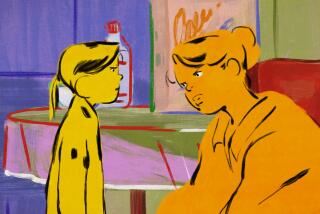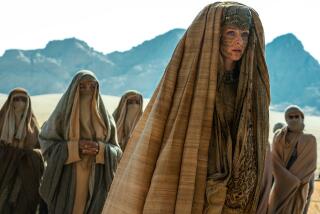‘Hunchback’: Sex, Lies--and Videotapes Too
- Share via
‘Join the Party!” shout the billboards and the bus boards announcing the arrival of Walt Disney’s 34th animated feature, “The Hunchback of Notre Dame.” This version of the malformed bell ringer’s saga is a dazzling film to be judged against the best films of any style, theme or genre and could capture Disney’s second best picture nomination for an animated film.
But it’s no party.
Adapted from what was essentially a monster story, Disney animators have created a beautiful, powerful film that I would not recommend for children under 8 or 9 years old.
“Hunchback” is a captivating spectacle of darkness, a foreboding tale of genocide, child abuse and repressed sexuality sprinkled with a little confetti and comic relief. If this film had been done in live action rather than animation, it would get at least a PG-13 rating.
Sexuality and sexual desire are the prevalent forces that drive the story. At the center of this calliope of sexuality is the beautiful Gypsy Esmeralda. Given voice by the graveled tones of Demi Moore and with the body of a Vargas girl, Esmeralda has libidos singing all over Paris. Her scarf dance, a la Salome, sets in motion a love quadrangle worthy of a Sam Shepard play. All three of the main male characters in the film are in love with Esmeralda: Quasimodo, the hunchback; Phoebus, the captain of the Paris guard; and Frollo, the medi-evil judge and Quasimodo’s guardian. And it gets them all in trouble.
It is Esmeralda’s enchanting beauty that draws Quasimodo out of seclusion and into a web of cruelty at the Feast of Fools. It is her gaze that causes Phoebus to defy orders. Her haunting vision awakens the repressed sexuality in Frollo and transforms him into a raging inferno of desire who must have Esmeralda or kill her.
Of course, Quasimodo’s love is hopelessly unrequited. Phoebus’ love is consummated and returned. Frollo’s love is met with the requisite disdain, and in the end everyone gets what he deserves and all is well and gay again in the streets of Paris. Is this the kind of party we want our children to join?
“Why couldn’t Quasi end up with her?” asked a 6-year-old girl at the end of a screening of the movie. Clearly Phoebus does not show the depth of feeling and complexity of Quasi, but he is drawn to be tall and handsome. Studies have shown that short men have a lot harder time getting dates in our culture. In this film the short man has a hump, so there’s no way he can get the girl. If the films our children see reinforce stereotypes, then how can things change?
The filmmakers have tried to make Esmeralda a strong and independent woman who can fend for herself, yet her ability to throw a punch only enhances her sexuality. (“What a woman!” exclaims a bystander as he watches Esmeralda fighting.) Is she really a role model for the young girls who will undoubtedly dress like her this Halloween?
All of the sexuality is subtle and sophisticated, except for an overly long and passionate kiss between Esmeralda and Phoebus that makes Quasimodo, and much of the audience, very uncomfortable. Is this all supposed to be OK because it’s animated? Or, is this telling of the “Hunchback” story really an exploration of the basic desires of men and the ultimate objectification of women? Though this may mirror the real-life desires of most men, is this desire the thing we want to expose our young children to?
Sex and sexuality come soon enough for our children. As evidenced by the growing statistics on teen pregnancy and AIDS, our children do not need to see movies that increase their curiosity or their drive toward sex. Animated or not, when the movie ends, Esmeralda and Phoebus are going to have sex and everybody knows it.
Sexuality and desire have been at the center of many of Disney’s animated “classics.” If you go back to “Snow White” and “Cinderella,” you find that the search for a man and the subservient role of women is reinforced. Beauty and sexuality are prized by the men in the stories, while being feared and hated by the women.
All of these women are waiting to be saved by the perfect man (“Someday my prince will come”). I certainly don’t want my daughter to wait for that. Nor do I want my son to live under that kind of pressure. Relationships are hard enough.
The current crop of Disney animation, including “The Hunchback of Notre Dame,” simply continues to portray a false and damaging reality to very young children. Think of Belle from “Beauty and the Beast,” Jasmine in “Aladdin” and Ariel in “The Little Mermaid.” All three of their stories revolve around the search for a man. The images and the messages may be subtle, but the effect is profound.
Twenty or 30 years ago, when Disney brought out an animated film, parents took their children once or twice. With the tremendous explosion of video, CD interactive and commercial tie-ins, children now live with the images from these films every day. They collect the dolls, dress up like the characters and listen to the music. They pretend they are the characters. Once the home video hits the VCR, our children watch the film over and over, emulating the voices and the gestures, memorizing the story and much of the dialogue. It all becomes a well-orchestrated part of their fantasy play. So what seemed subtle and over their heads is now overt and in their heads.
One of the darkest and most powerful images in “Hunchback” is of Frollo singing into the hellfire of Esmeralda’s vision, exclaiming that he must have her or she must die. The exact meaning of the words may be unclear to young children, but they do recognize the power of the words and they do remember. Is this what a 3-year-old should be repeating at the dinner table? “Mom, I will have her or she will die”?
In the end, it’s only a movie. Parents have been trusting the education and entertainment of their children to Walt Disney for generations. That probably isn’t going to change very much. With that power comes responsibility and it must be taken seriously.
It is obvious that with this telling of “The Hunchback of Notre Dame,” the producers have made a film that parents will not dread taking their children to. But by the time they get there it’s already too late. It’s marketing genius--and it’s irresponsible. I recommend that parents see the movie by themselves and then decide whether it is right for their children. Don’t just join the party.
More to Read
Only good movies
Get the Indie Focus newsletter, Mark Olsen's weekly guide to the world of cinema.
You may occasionally receive promotional content from the Los Angeles Times.








